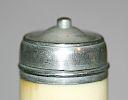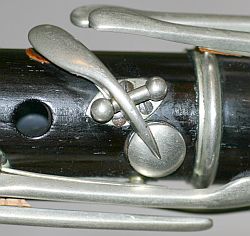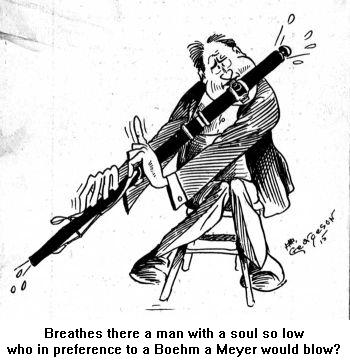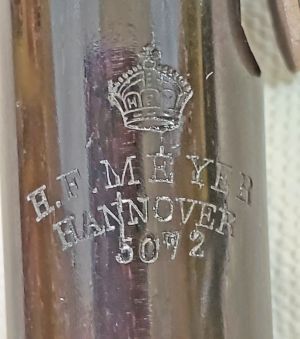
Eleven-key flute by H. F. Meyer

Six-key piccolo by H. F. Meyer
The firm of Heinrich Friedrich Meyer (1814–1897) flourished in Hannover from 1848 until the early 20th century. Paul Wetzler, in Die Flöte of 1905, calls Meyer an outstanding maker who enjoyed a worldwide reputation because of the uncommonly mellow [weichen] tone and excellent speech of his "Meyerflöte".
The Meyer firm produced a variety of simple system flutes, including Schwedler flutes. I am not familiar with all of their work, but one style (shown below) was most common and much imitated. We may presume that this is the Meyerflöte mentioned above, and it matches exactly the "System Meyer" flute shown by Wetzger in his list of systems.


Six-key piccolo by H. F. Meyer
The metal bands on the head joint of the flute above are part of a repair to the cracked ivory head. It is unfortunate that the crack was filled with some black material. The embouchure has been affected, but the flute still plays very well.
There is something subtle about shape of the head joint, primarily the barrel and endcap (both shown below), that seems particular to Meyer, and one can often recognize this from a distance or a photograph. There is commonly a narrow metal ring at the top of the upper center, just below the barrel. This shape can be imitated, of course, and so does not identify a flute as one actually made by Meyer. A stamp with the maker's name and a crown is more positive identification.




Other features to be found on flutes by Meyer are the angled G# key (already used by e.g. Monzani before 1820) and the use of posts on plates to mount the keys. Most late 19th century flutes have posts screwed directly into the wood, but Meyer used plates with three screws each. Most Meyer flutes I have seen have, like this one, the "standard" form of an eleven-key flute (including a side key for low b, a second touch for Bb, and the high e'''/d''' trill key, in addition to the "standard" eight keys of the English flutes). The G# key and its mounting on the Meyer flute is seen below.

The long F key and its touch are above the low B key and its touch, rather than below, perhaps the somewhat more common possibility. (This is certainly not unique to Meyer.)

Many late 19th century and early 20th century German flutes are stamped "nach Meyer"; in this context, the German word "nach" means "after" in the sense of "modeled on". Some of the flutes stamped "nach Meyer" are very good instruments, and some are quite crude. Shown below are the Meyer flute (the third flute down) and three "nach Meyer"s.

All have (cracked) ivory head joints and B-feet. The number of keys ranges from ten to thirteen. Only the real Meyer has a crown stamp and posts mounted on plates. I can tell from the shape or look of the head joints alone which is the real Meyer. The real Meyer, by the way, is by far the best player.
Following are the name stamps on the four flutes.




It is hard to read the stamps, but still, it can be seen that only the second one has the crown stamp. The last two have the word "nach". (The word "German" appears at the bottom of the fourth stamp.) The first has no "nach". It has been omitted from what I am sure is not a real Meyer flute.
The term "Meyer system" or "Meyer model" flute became common in the late 19th century, probably in part to have a name better than "ordinary flute" to distinguish it from the "Boehm flute". These terms were not used for the most inexpensive flutes, but came to mean almost any German-style simple system flute with eight or nine or more keys. One can see "genuine Meyer model" flutes offered by Sears, Roebuck & Co., and "System Meyer" flutes by G. & A. Klemm, on the catalogs page. The term "Meyer system" is unfortunate and should be avoided, because Meyer did not originate the system represented by these flutes (at least as the English word "system" is understood by flutists today). "Meyer model" or "nach Meyer" are acceptable, if the instrument really is similar to Meyer's flutes.
The following cartoon is one of the historical items preserved in the Dayton C. Miller Flute Collection at the Library of Congress. See their page on misnomers. (Six Meyer flutes are in that collection; numbers 2 and 3 appear identical to the one shown at the top of this page, except for the repair with silver rings.) I have added the original accompanying text to the scan. It originally appeared in 1915, at a time when the Boehm flute was becoming dominant in the U.S. but when simple system flutes were still very common. It is a bit mean-spirited. The Meyer player is shown using a mouthpiece-like device meant for amateurs who could not form an appropriate embouchure.

The instruments made by the H. F. Meyer firm that achieved fame as the "Meyerfloeten" date from c.1885 according to the New Langwill Index of Musical Wind Instrument Makers. But similar flutes were made by that firm much earlier. For a nice example from 1867, see Lynn-Meyer .
The Dayton C. Miller Collection contains six Meyer flutes (five with with six-finger note d' and one with six-finger note eb') as well as a few smaller flutes made by Meyer. See DCM .Four of the larger flutes are of exactly the same construction as the flute shown at the very top of this page and also reproduced at the top of the photo below. (But the metal rings have been removed from the headjoint, which headjoint was then re-repaired by Jon Cornia.) This flute and the four with ivory heads from the DCM collection may be called the "standard model".

But the other two Meyerflutes on the DCM site (DCM 0085, and DCM 0087) are later models of a somewhat different and rarer design, that I will call "newer models"! These two are not exactly the same, but both have features not found on the standard models, including:
(1) an ebonite head (not ivory),
(2) more than 11 keys, including a second G# key,
(3) key posts screwed directly into the wood,
(4) no narrow metal ring at the upper end of the body,
(5) significant use of rods and sleeves, and a few needle springs, in the mechansism, and
(6) a long key for the high a'''/g''' trill is supplied, with a thin touch for RH1 between finger holes 4 and 5 (just as on Schwedler flutes.)
There may be other variations that I cannot make out in the photos on the DCM webpage.
The bottom flute in the above photo shows a newer model Meyer flute in my collection. It shares features 2-6 above but has an ivory headjoint. (However, while the ivory headjoint is a genuine Meyer head, it lacks the serial number (5072) that is stamped on the body and low joint of the flute, so I am not sure that the ivory head is the original headjoint that was supplied with the flute.) In this photo, there does not appear to be much difference between the flutes, but the photo below shows the additions made to this newer model Meyer flute over the standard model.

This newer model flute has 13 keys (the newer models on the DCM site have 12 and 14), the extras beyond the 11 of the standard Meyer flute being an exta G# key and a third octave A/G trill key. There is a black bakelite thumbrest to the left of the touch of the left hand Bb key.
The Meyer stamp is more detailed and than other Meyer stamps I have seen; it is even possible, on this flute, to make out the initials HFM inside the crown in the stamp. (Also on DCM 0087.)

